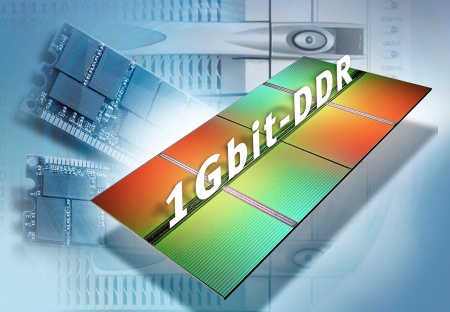Infineon Samples the World`s Smallest 1-Gbit Double Data Rate SDRAMs - 110-nm Technology and Dual-Die-Stack Allow Highest Density on Smallest Space
Munich, Germany - August 26, 2003 - Infineon Technologies AG (FSE/NYSE: IFX) today announced that it has shipped first samples of its 1-Gbit Double Data Rate (DDR) Synchronous DRAM (SDRAM) to selected key customers. The devices are fabricated using the companys advanced 110nm CMOS process. At only 160mm² chip size they are the industrys smallest 1-Gbit DDR SDRAMs to date.
The new 1-Gbit DRAM is packaged in a standard 400-mil, 66-pin Thin Small Outline Package (TSOP) or a 68-ball Fine-pitch Ball Grid Array (FBGA) for space-constrained applications. Supported organizations are x4, x8 and x16. The 1-Gbit Double Data Rate SDRAM covers the whole range of popular DDR data rates from DDR266 through DDR400 operating at 133 MHz through 200 MHz clock speeds, respectively.
Infineon is proud to again have the smallest die size of an upcoming new DRAM generation, said Dr. Harald Eggers, CEO of Infineons Memory Products Group. This once again impressively underlines the value of our advanced trench-cell DRAM technology in the industry. It enables the most economic production of the new DRAM generations, which will further push out the memory density barrier in high-end servers and workstations and thereby help to improve speed, performance and user-friendliness of todays computers.
To achieve the highest memory density per module, Infineon will use a stacked version of the FBGA package to produce the 4-Gbyte registered modules. The technology, called Dual Die Stack, provides a second silicon chip on top of the first, encapsulating the resulting die stack in a regular, albeit higher, fine-pitch ball grid array package. This innovative form of stacking allows Infineon to achieve unprecedented memory density per board area, but also offers superior electrical and thermal properties of the resulting memory component. Alternatively, the 4-Gbyte registered DIMM will also be available based on stacked TSOP packages.
The 1-Gbit DDR SDRAM will be used primarily to offer high-density registered and unbuffered modules for the high-end server and workstation market. Target products are registered Dual-Inline Memory Modules (DIMMs) of 4-Gbyte and 2-Gbyte density as well as unbuffered DIMMs of 2-Gbyte density. Small-Outline DIMMs (SO-DIMMs) for notebook computers will be offered in 2-Gbyte and 1-Gbyte densities using the new generation memories. All modules will start sampling in the fourth quarter of 2003 and enter into volume production early 2004.
Initially manufactured in Infineons Dresden facility, an integral part of the companys fab cluster of semiconductor fabs on three continents, the new 1-Gbit DDR SDRAM will generally become available in the 4th quarter of 2003.
The new 1-Gbit DRAM is packaged in a standard 400-mil, 66-pin Thin Small Outline Package (TSOP) or a 68-ball Fine-pitch Ball Grid Array (FBGA) for space-constrained applications. Supported organizations are x4, x8 and x16. The 1-Gbit Double Data Rate SDRAM covers the whole range of popular DDR data rates from DDR266 through DDR400 operating at 133 MHz through 200 MHz clock speeds, respectively.
Infineon is proud to again have the smallest die size of an upcoming new DRAM generation, said Dr. Harald Eggers, CEO of Infineons Memory Products Group. This once again impressively underlines the value of our advanced trench-cell DRAM technology in the industry. It enables the most economic production of the new DRAM generations, which will further push out the memory density barrier in high-end servers and workstations and thereby help to improve speed, performance and user-friendliness of todays computers.
To achieve the highest memory density per module, Infineon will use a stacked version of the FBGA package to produce the 4-Gbyte registered modules. The technology, called Dual Die Stack, provides a second silicon chip on top of the first, encapsulating the resulting die stack in a regular, albeit higher, fine-pitch ball grid array package. This innovative form of stacking allows Infineon to achieve unprecedented memory density per board area, but also offers superior electrical and thermal properties of the resulting memory component. Alternatively, the 4-Gbyte registered DIMM will also be available based on stacked TSOP packages.
The 1-Gbit DDR SDRAM will be used primarily to offer high-density registered and unbuffered modules for the high-end server and workstation market. Target products are registered Dual-Inline Memory Modules (DIMMs) of 4-Gbyte and 2-Gbyte density as well as unbuffered DIMMs of 2-Gbyte density. Small-Outline DIMMs (SO-DIMMs) for notebook computers will be offered in 2-Gbyte and 1-Gbyte densities using the new generation memories. All modules will start sampling in the fourth quarter of 2003 and enter into volume production early 2004.
Initially manufactured in Infineons Dresden facility, an integral part of the companys fab cluster of semiconductor fabs on three continents, the new 1-Gbit DDR SDRAM will generally become available in the 4th quarter of 2003.
About Infineon
Infineon Technologies AG, Munich, Germany, offers semiconductor and system solutions for the automotive and industrial sectors, for applications in the wired communications markets, secure mobile solutions as well as memory products. With a global presence, Infineon operates in the US from San Jose, CA, in the Asia-Pacific region from Singapore and in Japan from Tokyo. In the fiscal year 2002 (ending September), the company achieved sales of Euro 5.21 billion with about 30,400 employees worldwide. Infineon is listed on the DAX index of the Frankfurt Stock Exchange and on the New York Stock Exchange (ticker symbol: IFX). Further information is available at www.infineon.com.
Information Number
INFMP200308.112
Press Photos
-
 The 1-Gbit Double Data Rate (DDR) Synchronous DRAMs (SDRAM) are fabricated using the company's advanced 110nm CMOS process. At only 160mm² chip size they are the industry's smallest 1Gbit SDRAMs to date.Press Photo
The 1-Gbit Double Data Rate (DDR) Synchronous DRAMs (SDRAM) are fabricated using the company's advanced 110nm CMOS process. At only 160mm² chip size they are the industry's smallest 1Gbit SDRAMs to date.Press PhotoJPG | 515 kb | 1535 x 1063 px
Press PhotoJPG | 9 kb | 160 x 111 px
